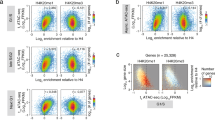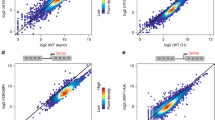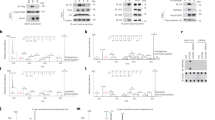Abstract
Currently, the mammalian heterochromatic proteins HP1α, HP1β and the pan-nuclear HP1γ are considered 'gatekeepers' of methyl-K9-H3-mediated silencing. Understanding how the binding of these proteins to post-translationally modified histones is switched on and off will further our knowledge of how the histone code is modulated. Here, we report that all three HP1 isoforms can be extensively modified, similar to histones, suggesting that the silencing of gene expression may be further regulated beyond the histone code. To assess the potential impact of these modifications, we analysed the phosphorylation of HP1γ at Ser 83 as a 'model modification'. We demonstrate that P-Ser 83-HP1γ has an exclusively euchromatic localization, interacts with Ku70 (a regulatory protein involved in multiple nuclear procesess), has impaired silencing activity and serves as a marker for transcription elongation. These observations predict that regulation of silencing by methyl-K9-H3 through modification of mammalian HP1 proteins may be more complex than previously thought and suggests the existence of an HP1-mediated 'silencing subcode' that underlies the instructions of the histone code.
This is a preview of subscription content, access via your institution
Access options
Subscribe to this journal
Receive 12 print issues and online access
$209.00 per year
only $17.42 per issue
Buy this article
- Purchase on Springer Link
- Instant access to full article PDF
Prices may be subject to local taxes which are calculated during checkout





Similar content being viewed by others
References
Jenuwein, T. & Allis, C. D. Translating the histone code. Science 293, 1074–1080 (2001).
Eissenberg, J. C. Molecular biology of the chromo domain: an ancient chromatin module comes of age. Gene 275, 19–29 (2001).
Bannister, A. J. et al. Selective recognition of methylated lysine 9 on histone H3 by the HP1 chromo domain. Nature 410, 120–124 (2001).
Lachner, M. et al. Methylation of histone H3 lysine 9 creates a binding site for HP1 proteins. Nature 410, 116–120 (2001).
Minc, E., Courvalin, J. C. & Buendia, B. HP1γ associates with euchromatin and heterochromatin in mammalian nuclei and chromosomes. Cytogenet. Cell Genet. 90, 279–284 (2000).
Eissenberg, J. C., Ge, Y. W. & Hartnett, T. Increased phosphorylation of HP1, a heterochromatin-associated protein of Drosophila, is correlated with heterochromatin assembly. J. Biol. Chem. 269, 21315–21321 (1994).
Huang, D. W. et al. Distinct cytoplasmic and nuclear fractions of Drosophila heterochromatin protein 1: their phosphorylation levels and associations with origin recognition complex proteins. J. Cell Biol. 142, 307–318 (1998).
Zhao, T. & Eissenberg, J. C. Phosphorylation of heterochromatin protein 1 by casein kinase II is required for efficient heterochromatin binding in Drosophila. J. Biol. Chem. 274, 15095–15100 (1999).
Minc, E. et al. Localization and phosphorylation of HP1 proteins during the cell cycle in mammalian cells. Chromosoma 108, 220–234 (1999).
Koike, N. et al. Identification of heterochromatin protein 1 (HP1) as a phosphorylation target by Pim-1 kinase and the effect of phosphorylation on the transcriptional repression function of HP1(1). FEBS Lett. 467, 17–21 (2000).
Zhao, T., Heyduk, T. & Eissenberg, J. C. Phosphorylation site mutations in heterochromatin protein 1 (HP1) reduce or eliminate silencing activity. J. Biol. Chem. 276, 9512–9518 (2001).
Badugu, R., Yoo, Y., Singh, P. B. & Kellum, R. Mutations in the heterochromatin protein 1 (HP1) hinge domain affect HP1 protein interactions and chromosomal distribution. Chromosoma 113, 370–384 (2005).
Zhou, X. M. & Fishman, P. H. Desensitization of the human β1-adrenergic receptor. Involvement of the cyclic AMP-dependent but not a receptor-specific protein kinase. J. Biol. Chem. 266, 7462–7468 (1991).
Vakoc, C. R., Mandat, S. A., Olenchock, B. A. & Blobel, G. A. Histone H3 lysine 9 methylation and HP1gamma are associated with transcription elongation through mammalian chromatin. Mol. Cell 19, 381–391 (2005).
Brasher, S. V. et al. The structure of mouse HP1 suggests a unique mode of single peptide recognition by the shadow chromo domain dimer. EMBO J. 19, 1587–1597 (2000).
Cowieson, N. P., Partridge, J. F., Allshire, R. C. & McLaughlin, P. J. Dimerisation of a chromo shadow domain and distinctions from the chromodomain as revealed by structural analysis. Curr. Biol. 10, 517–525 (2000).
Smothers, J. F. & Henikoff, S. The HP1 chromo shadow domain binds a consensus peptide pentamer. Curr. Biol. 10, 27–30 (2000).
Gaudin, V. et al. Mutations in LIKE HETEROCHROMATIN PROTEIN 1 affect flowering time and plant architecture in Arabidopsis. Development 128, 4847–4858 (2001).
Thiru, A. et al. Structural basis of HP1–PXVXL motif peptide interactions and HP1 localisation to heterochromatin. EMBO J. 23, 489–499 (2004).
Song, K., Jung, Y., Jung, D. & Lee, I. Human Ku70 interacts with heterochromatin protein 1α. J. Biol. Chem. 276, 8321–8327 (2001).
Metzger, E. et al. LSD1 demethylates repressive histone marks to promote androgen-receptor-dependent transcription. Nature 437, 436–439 (2005).
Gebelein, B. & Urrutia, R. Sequence-specific transcriptional repression by KS1, a multiple-zinc-finger-Kruppel-associated box protein. Mol. Cell Biol. 21, 928–939 (2001).
Morris, D. P., Michelotti, G. A. & Schwinn, D. A. Evidence that phosphorylation of the RNA polymerase II carboxyl-terminal repeats is similar in yeast and humans. J. Biol. Chem. 280, 31368–31377 (2005).
Acknowledgements
The authors wish to thank S. Delgado and T. Clark for the significant technical assistance they provided for experiments that led to the results shown in Figs 1 and 4, respectively. This work was supported by funding from the National Institutes of Health (grants DK52913 and DK56620) and the Mayo Kogod Center for Aging Research (R. U.). G. L. was supported by the Mayo Clinic National Institutes of Health training grant in Digestive Diseases.
Author information
Authors and Affiliations
Corresponding author
Ethics declarations
Competing interests
The authors declare no competing financial interests.
Supplementary information
Supplementary Information
Supplementary Figures S1, S2, S3 and S4 (PDF 429 kb)
Rights and permissions
About this article
Cite this article
Lomberk, G., Bensi, D., Fernandez-Zapico, M. et al. Evidence for the existence of an HP1-mediated subcode within the histone code. Nat Cell Biol 8, 407–415 (2006). https://doi.org/10.1038/ncb1383
Received:
Accepted:
Published:
Issue Date:
DOI: https://doi.org/10.1038/ncb1383
This article is cited by
-
Diverse silent chromatin states modulate genome compartmentalization and loop extrusion barriers
Nature Structural & Molecular Biology (2023)
-
Nanobody-mediated control of gene expression and epigenetic memory
Nature Communications (2021)
-
Unravelling HP1 functions: post-transcriptional regulation of stem cell fate
Chromosoma (2021)
-
Citrullination of HP1γ chromodomain affects association with chromatin
Epigenetics & Chromatin (2019)
-
Mechanisms Underlying the Regulation of HP1γ by the NGF-PKA Signaling Pathway
Scientific Reports (2018)



